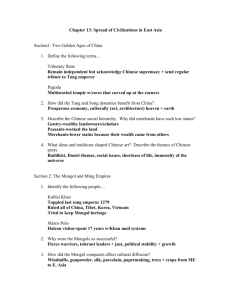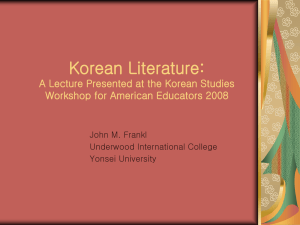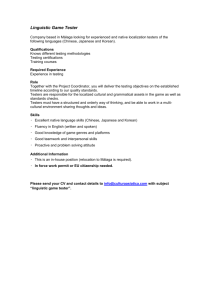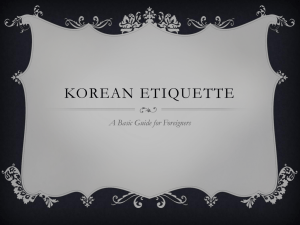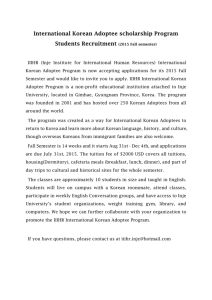Why I wrote this book - Kuk Sool Won of Clear Lake
advertisement
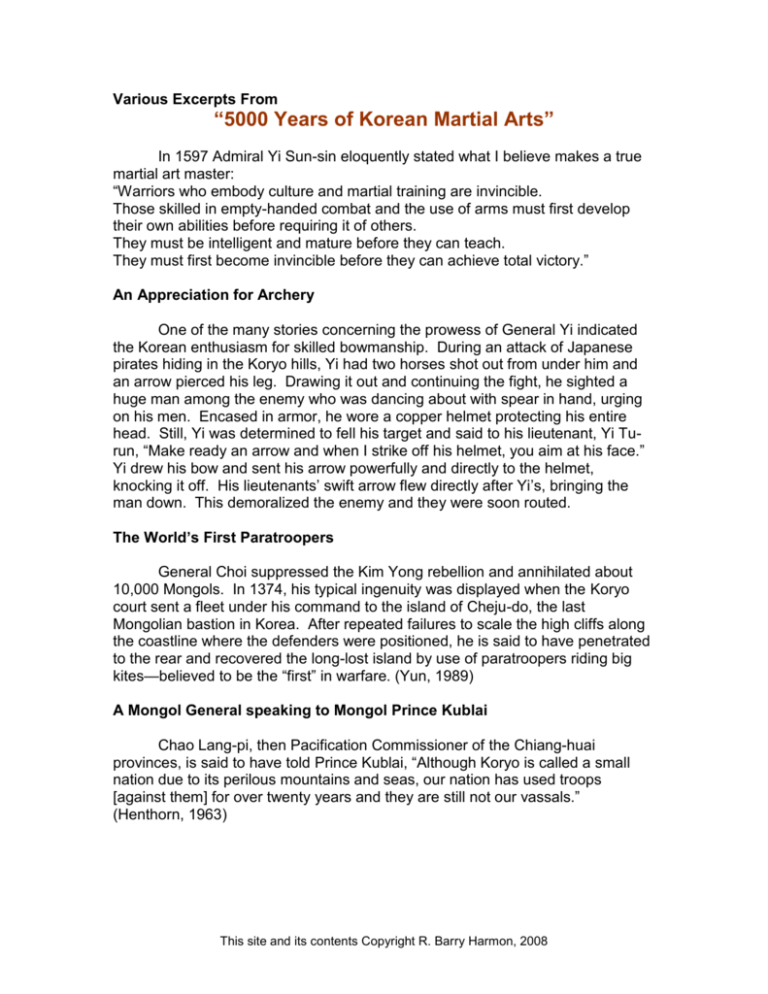
Various Excerpts From “5000 Years of Korean Martial Arts” In 1597 Admiral Yi Sun-sin eloquently stated what I believe makes a true martial art master: “Warriors who embody culture and martial training are invincible. Those skilled in empty-handed combat and the use of arms must first develop their own abilities before requiring it of others. They must be intelligent and mature before they can teach. They must first become invincible before they can achieve total victory.” An Appreciation for Archery One of the many stories concerning the prowess of General Yi indicated the Korean enthusiasm for skilled bowmanship. During an attack of Japanese pirates hiding in the Koryo hills, Yi had two horses shot out from under him and an arrow pierced his leg. Drawing it out and continuing the fight, he sighted a huge man among the enemy who was dancing about with spear in hand, urging on his men. Encased in armor, he wore a copper helmet protecting his entire head. Still, Yi was determined to fell his target and said to his lieutenant, Yi Turun, “Make ready an arrow and when I strike off his helmet, you aim at his face.” Yi drew his bow and sent his arrow powerfully and directly to the helmet, knocking it off. His lieutenants’ swift arrow flew directly after Yi’s, bringing the man down. This demoralized the enemy and they were soon routed. The World’s First Paratroopers General Choi suppressed the Kim Yong rebellion and annihilated about 10,000 Mongols. In 1374, his typical ingenuity was displayed when the Koryo court sent a fleet under his command to the island of Cheju-do, the last Mongolian bastion in Korea. After repeated failures to scale the high cliffs along the coastline where the defenders were positioned, he is said to have penetrated to the rear and recovered the long-lost island by use of paratroopers riding big kites—believed to be the “first” in warfare. (Yun, 1989) A Mongol General speaking to Mongol Prince Kublai Chao Lang-pi, then Pacification Commissioner of the Chiang-huai provinces, is said to have told Prince Kublai, “Although Koryo is called a small nation due to its perilous mountains and seas, our nation has used troops [against them] for over twenty years and they are still not our vassals.” (Henthorn, 1963) This site and its contents Copyright R. Barry Harmon, 2008 Mongol Commander Sartaq Killed by Modest Korean Monk Koryo’s decision to resist the Mongols provoked a second invasion by Sartaq which proved fatal to the Mongol commander. In his attack on the city of Ch’oin-song (Yongin) in 1232, he was struck and killed by an arrow sprung from the bow of the Buddhist monk Kim Yunhu. Records alternatively say that the monk completely denied being armed or that it was a “chance” shot. Kim, clearly observed to have shot Sartaq, declined an appointment as Supreme General as a reward for killing the great Mongol commander, saying, “At the time of the battle I was without bow and arrows. How can I presume to falsely receive an important reward?” Such a high command would not have been offered if there had been the slightest doubt on Ch’oe’s part that it was the monk who brought down Sartaq. However, such an attitude on the part of highly adept monks was not unknown. An old Mongol General inspection of a Siege During the siege of Kuju, an old Mongol general, 70 years old, was touring beneath the city walls to inspect the ramparts and equipment. He sighed and said: “I have followed the army since I bound my hair [into plaits as a youth] and so I am accustomed to seeing the cities of the Earth attacked and fought over. Still I have never seen [a city] undergo an attack like this which did not, in the end, submit.” The Mongols said: “This city has withstood many with few. Heaven protects it, not the strength of men.” Thus satisfied that they had saved face by identifying their victors as sustained by supernatural power, they abandoned their siege and left. For his valiant defense of Kuju, Pak was appointed Senior Councilor of the Royal Chancellery. Ch’oe told him, “Sir, in the nation, [your] fidelity is really incomparable.” General Kyongson leads his “Dare-death squad” With a large Mongol force at the south gate of the city, Kyongson, leading his twelve soldiers (a “dare-death squad”) as well as all the patrols of the city, gave this order to the soldiers as they were going out of the city gate: “Do not think of your own lives. If fate decrees, die, but do not fall back.” The patrols all threw themselves on the ground and would not obey. Kyongson ordered them all to go back into the city and then with only his dare-death squad of twelve soldiers he advanced into battle. Kim himself shot an arrow and knocked down one mounted soldier who rode with a black flag in the vanguard of the Mongol force. Consequently, Kim’s twelve skoldiers were encouraged and fought strenuously. Hit by an arrow, Kyongson then formed his lines and called his small group to return. This site and its contents Copyright R. Barry Harmon, 2008 The strong sprit of General Kyongson is displayed Before retreating, the Mongols lit accumulated brush near the wood gates. After they regrouped, they returned to the assault. Kyongson had positioned himself in a chair to direct the fighting, during which a Mongol catapult slung a missile his way. It crossed the wall and landed directly behind him, killing his guards. His men begged him to move to a safer location. He refused, telling them, “If I am moving, then the hearts of all the soldiers will move also.” The expression on his face was adamant and without concern and, in the end, he did not move. A story of martial spirit and training of the Korean soldier General Kim Yu-sin of Silla and his group arrived late for an appointed meeting at the T’ang encampment. Ting-fang was about to have the Silla governor Kim Munyong decapitated at the camp gate because Yu-sin and the others missed the appointed schedule. Yu-sin said to his horde, “The Great General did not witness the campaign at Hwangsan, yet is treating our missing the appointed schedule as a crime. I cannot accept this shame while guiltless. We must first fight a decisive battle with T’ang and then crush Paekche.” He stood at the camp gate gripping a battle-axe, his hair bristling with anger, and the jeweled sword at his waist leapt instinctively from its scabbard. Ting-fang’s General of the Right Tung Pao-liang stepped on Ting-fang’s foot and said, “The troops of Silla are going to revolt,” whereupon Ting-fang absolved Munyong of any crime. (Jamieson, 1969) Heroes eager to die for their country Paekche responded to Silla’s seizer of border towns with a swift thrust by crack troops. All Silla officers and men except Simna retreated in scattered confusion. Holding out alone, Simna drew his sword and, cursing madly, eyes ablaze with fury, lopped off the heads of several scores of men. The bandits were so frightened that they pulled back their troops, not daring to confront him. They referred to “Simna at the “Flying General of Silla.” It was also said among them that “While Simna still lives, one does not approach Paeksong.” Chinese borrowing from Koreans That the Chinese borrowed at this time from Koreans is a matter of record. In the Chinese battle with Koguryo forces for the renowned fortress of Laio-tung, the Chinese were materially aided by Paekche designed armor which Paekche had sent as a gift to the Chinese Emperor. (Hulbert, 1962) As history moved on and records were lost it is most certain this armor by Paekche came to be known a Chinese not Korean. Many mistakes of this type have occurred throughout Korean history. How many weapons, armor, literature and other items that were This site and its contents Copyright R. Barry Harmon, 2008 Korean in origin, transmitted to China or Japan, and thought to have originated in those countries has history recorded incorrectly? The influence of Korea on early Japan Even as late as 815 A.D., 30 percent of the nobility in Japan claimed nonJapanese ancestry. An early census shows that many of the nobility had Korean names. The Korean King Syong-myong of Paekche introduced Buddhism to Japan through a laudatory memorial concerning its teachings, sent in 552 A.D., according to the Japanese text Nihongi. The significant influence of Korea on Japanese culture was further underlined when, in October, 1978, Japan’s most prestigious private museum, the Yammato Bunka-kan of Nara Prefecture, opened an exhibit of about 70 paintings which they identified as “Koryo Buddhist.” Previously, most of these works of art, stolen from Korea by Japanese pirates, had been labeled Chinese or Japanese. The difficulty of obtaining information on Korean arms Boots also mentions in his Introduction the great difficulty in obtaining information on Korean arms. “There remain living today only a very few Koreans who have intimate knowledge of the old military things. None of them are writing their memoirs and soon they will be gone.” This statement illustrates the circumstances found in Korea at the end of World War II, when Koreans who held onto the knowledge of an indigenous Korean system were few and often secluded, and teachers of Japanese martial arts were the only approved instructors. This situation began the amalgamation of Japanese martial arts with the remaining fragments of the Korean systems still in general circulation. Koreans were famous for Bow and Arrows Since ancient times, Koreans have been identified with archery, inventing the compound reflex bow. In the old books of China, the people of Korea were referred to by the use of a character incorporating “great” and the character for “bow.” Skill with the great bow was so characteristic of the early Koreans that the Chinese used the word to refer to them and, later, all foreigners or “barbarians” as the word came to be translated. This site and its contents Copyright R. Barry Harmon, 2008 Sword commissioned by the King and given to a favorite body guard The best Korean sword seen by Boots, and in his collection, had a large double-edged blade 3’4” (1 m) long and two inches (5.08 cm) wide, weighing 53/4 pounds. For comparison an American Civil War saber weighs 1-3/4 pounds. On the 10” (25.43 cm) handle was an elaborate inlaid silver design with Asian characters and a heavy hilt of lotus leaf design, vertically placed. As discussed before, from the Asian inscription we shouldn’t infer that there is anything intrinsically Chinese about the Korean sword itself. At that time when anyone wanted to write in a formal manner, an Asian iconography now identified as Chinese was used. The characters were inlaid with gold on one side of the blade. On the other side, also in gold, was the constellation of the Great Bear with two added stars which, with one in the handle of the dipper, the Koreans call the “Three Tiger Stars.” This indicates great good fortune in military things on the day of the lunar calendar when the “Tiger Day” comes on the “Tiger Month” of the “Tiger Year.” This sword, Boots was told, was of a design given by the king to a favorite officer of his personal bodyguard and was worn slung across the back by this mounted officer. This particular piece was ordered to be made on this This site and its contents Copyright R. Barry Harmon, 2008 propitious day in the 18th year of 1794. The scabbard was made of wood covered with black lacquer with a copper cap. This site and its contents Copyright R. Barry Harmon, 2008
